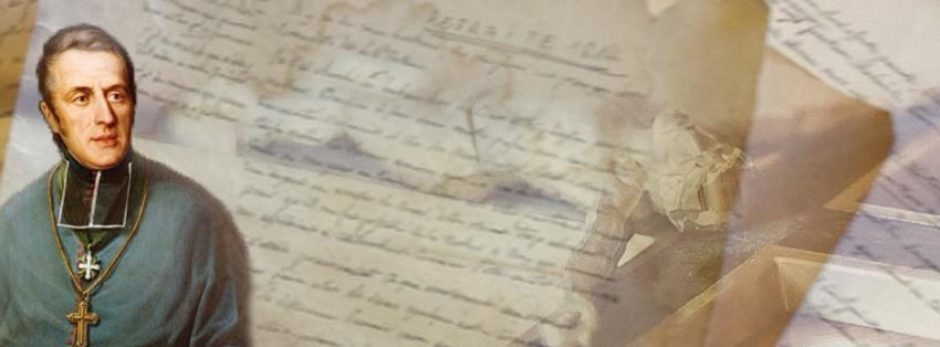OTTAWA BEFORE THE ARRIVAL OF THE OBLATES
Is my town like Bytown? How can I make a healing contribution?
Just three years after the arrival of the Oblates in Canada, they were in demand in many dioceses. One of the requests was for a community to be established in Bytown (present-day Ottawa). Eugene realized its importance and responded positively. Before we begin to follow the mission of the Oblates there, let us get some background.
Bishop Bourget was concerned about the western part of his vast diocese that he had visited in October 1840. It covered the northern part of the Ottawa River. The “Great” river was known in contemporary English as the Ottawa River. Later it was to have the French name of the “Outaouais” in Lower Canada (later to become Quebec) while south of the river was known as Upper Canada (later Ontario). There were native peoples scattered throughout the territory as far as Temiscamingue and James Bay. It was now opening up to colonization and the timber industry.
Already in 1791 a Government commission had recommended the establishment of a town at the meeting of the Ottawa and Rideau Rivers, near the mouth of the Gatineau River. In 1800 a little group of foresters came up from the United States and settled beside the Chaudière falls to form the village that would become Hull. In 1826 the Government asked colonel By to build a canal with locks connecting the Ottawa River with the Saint Lawrence River and to survey the land with a view to building a new city. We are told that Bytown quickly acquired an unenviable reputation. “The centre of the canal works, meeting place of wood cutters, this cosmopolitan place was soon the scene of disorder caused by race hatred and religious antagonism, the abuse of alcoholic drink and often the place where might became right” (Ibid. p. 64).
Beginning in 1827 and until 1842 about a dozen priests lived for brief periods in this rowdy milieu. Then, in 1842 and until the arrival of the Oblates the resident priest was Father Patrick Phelan, future coadjutor of Kingston. Besides the central parish there were about a dozen missions spread throughout the surrounding area. The success of the missionary ministry of the Oblates around Montreal inspired Bishop Bourget to entrust the care of this vast developing area to them. However, since Bytown was on the side of Kingston, he promptly communicated his views on the matter both to the Oblates and to Bishop Phelan.
This is what he wrote to Bishop de Mazenod on October 19, 1843: “It is a matter of finding an establishment for them in a newborn town in the diocese of Kingston, called Bytown… This town is at the centre of all the communications routes on the Great River known as the Ottawa. It is here that the thousands of men land who are engaged in the cutting down of the forests that grow along this beautiful and wonderful river. They are all worthy of the zeal of your children. From there the men will have to leave to go and evangelize what we call here the “chantiers” (loggers’ camps)… Besides, about 60 or 80 leagues from there are the hunting grounds of the native peoples… The missionaries who work for their conversion will need a central establishment from which to set out as they journey to these infidels and to which to return to work for the salvation of the whites… For the time being Bytown offers this precious advantage.” (Registre des lettres, Vol. 3, pp. 206-208, Archbishop’s House, Montreal).
Alexandre Taché, o.m.i. in https://www.omiworld.org/lemma/ottawa-diocese-1844-1861/
This entry was posted in
WRITINGS. Bookmark the
permalink.

This morning’s offering has caused me a little confusion and sadness – only because of some of the language that is being used. I am not wanting it to be changed, dropped or hidden. Sadly the wording and some of the ideas of that time were offensive, often leading to cruelty and inhumane treatment of others. Love demands forgiveness and compassion of and for all of us.
Sitting here this morning looking closely and reflecting (rather than skimming over and excusing, or worse ignoring) the humanness of the many peoples arriving on lands that were/are new only to them and trying to make them their own – often conquering rather than sharing…
I reflect for a moment on Jesus and his disciples and the fear that the rulers and priests of his time (pharisees and scribes) had for someone so different. I have in my mind the image of Saul on his horse riding to destroy and so protect – until he met Jesus… I think of St. Eugene and so many before him who on one Good Friday experienced the love of Jesus on the cross, dying out of love for him. Like Saul his experience was deeply personal.
If I could draw an image, it would be a living wave of water running over us through time healing and transforming us – mankind. I think I want to call it ‘The Living Waters’ and I stop for this is what these early Oblates and other brought here to us.
Now I can go back and begin to read again, without fear, anger, shame…
I think of the Oblate Motto: “we are sent to evangelize the poor: the poor are evangelized.” Not just a ‘they’ or ‘we’ thing, but also a ‘me’ thing. For in a small sense this morning I have been, once again, evangelized.
I thank God, asking once again to be washed clean from my sin, my weakness and my fears…
I go now to begin my reflection again…